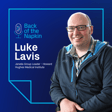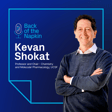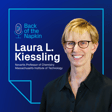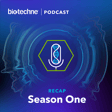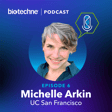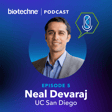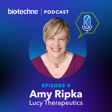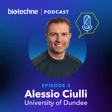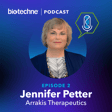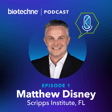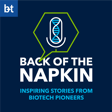Origins of Discoveries
00:00:03
Speaker
A discovery is said to be an accident meeting a prepared mind but every story behind the discovery is different. Perhaps the idea is conceived in a light bulb moment or a brainstorming session or captured in scribblings on the back of a napkin.
Podcast Introduction
00:00:21
Speaker
Here we introduce you to scientific pioneers taking you beyond their publications and into innovation corner to hear the untold stories behind their discoveries. This podcast is brought to you by Biotechny, and I'm your host, Alex Maloney.
Trash Insights and Raccoons
00:00:41
Speaker
The contents of your ah rubbish bin or garbage bin for the American listeners contains a huge amount of information about you and how you live. And the raccoons rooting through this are going to find out what you eat, what you ordered from Amazon, what medication you're taking, and many other personal bits of information. It's like a breadcrumb trail to your daily routine.
Exosomes: A Diagnostic Revolution
00:01:05
Speaker
Well, the cells in our body have an equivalent system whereby key bits of information are carried around in vesicles called exosomes that you'll find in ah biological fluids like blood and urine.
00:01:22
Speaker
And because of this, the field of diagnostics is witnessing a transformation. And that's thanks to our guest today, Dr. Johann Schog, founder and CSO of Exosome Diagnostics. Johan has one of those curious minds that's a perfect environment for innovation and it's an insatiable curiosity that led Johan to the pivotal discovery that these exosomes contain RNA from the cell they came from and this presented a fantastic opportunity for identifying biomarkers of diseases like cancer and the pertinent example here being prostate cancer where with just a cup and some privacy a urine sample is all that is needed.
Exosomes and Prostate Cancer Diagnostics
00:02:14
Speaker
to rule out the risk of a patient having high-grade prostate cancer, thereby eliminating the need for invasive and unnecessary tissue biopsy procedures. But prostate cancer isn't the final frontier. In fact, this technology has the potential to literally soar into space.
NASA and Exosome Research
00:02:36
Speaker
As NASA, one day as you'll hear in this episode, called up Johan to see if exomes can be used to diagnose a syndrome called VIPP. That's vision impairment and intracranial pressure, something that's been incredibly restrictive to astronauts on extended space missions on the International Space Station. And spoiler alert, they sure can help.
00:03:03
Speaker
But let's ground ourselves for a second with a brief note.
Exosome Diagnostics' Evolution
00:03:07
Speaker
Exozome Diagnostics became part of Biotechnique in 2018, which made us take pause when inviting Johan on as a guest. However, this podcast has and always will be focused on introducing scientific the pioneers and the fantastic and intriguing stories behind their discoveries. And today's episode is no exception. We've been incredibly excited to share this episode because Johan's story, mindset and approach to problem solving is too intriguing to overlook and is such a perfect fit for back of the napkin.
00:03:53
Speaker
Hi, yeah and welcome to Back of the Knack in podcast. Thanks for having me at the Exosome Diagnostics site in Boston. When I saw that we were booked into the war room, I was thinking, oh boy, you are what goes on in here? that was an interesting story, but there we we named all of our conference rooms here at Exosome Diagnostics after the the conference rooms in the White House. So we have a situation room, the war room and nice control room. Yeah. Yeah. The other thing I really liked about ah when I visited here was I went into your cafeteria, I went to the coffee ma machine and saw you've got an exosome diagnostics blend of coffee, which I'm drinking right now. It's delicious. yeah I'm thinking of putting in for a transfer over here. Yeah. No, it's one of the the perks that we have here. Very good.
00:04:48
Speaker
Okay. Yeah. And let's start off by getting to know you a little bit
Johann's Swedish Roots
00:04:52
Speaker
then. Sure. so ah Where did you grow up? So I grew up in the northern part of Sweden, in ah in a town called Umil. And um it's a university town of about 120,000 people. And I think a third of the population is at the university or works at the university. So um it's ah it's a very nice town, but smaller and about an hour flight north of Stockholm.
00:05:23
Speaker
And what was it like living there then? So what what kind of inspired you to get into science and medicine? Yeah, that's a great question. I've always been very competitive when it comes to sports and have done sports my whole life. and what like That was my passion. So I played soccer, I played ice hockey as you do in in Sweden, of course. um But ah my the the biggest one that I've done is is judo. That's what I've sort of kept up with my whole life. So you're still doing Tito now? Yes. And and um I think that sort of... and competitive and sports world, and that mentality it's is very very good to have in in science because as you know, science is
00:06:18
Speaker
hard and it's 90% bad news and repeating experiments and 10% success. and So you need to have a little bit of perseverance and and want to get things done. So I think that kind of helped me. um I always had good teachers in science and that sort of put me on the path.
Johann's Academic Journey
00:06:42
Speaker
I did have a um yeah I didn't know to choose between medicine and becoming a medical doctor or more medical science. So at the university I picked a program called the biomedical program or biomedicine which had a little bit of both.
00:07:06
Speaker
yeah it was you were studying together with the medical students for some of the like the courses, the anatomy and physiology. And then when they did more patient-oriented courses, we did more science-based courses. So that was a good start, sort of get to feel what what you like more. And I pivoted more toward the science part. And um um I think
00:07:40
Speaker
Well, a lot of things that happen in life is unplanned and and there are small events that change your paths and and and takes you down one particular direction. Yeah. There's something really exciting about that, isn't is there? Not knowing what your next stop is going to be, but being open to these opportunities. Exactly. no and And you can't plan everything. And I think my life has been... like that as well. ah you You can have so sort of a plan, but the best plan is to sometimes change plan and be a little dynamic.
Australia's Influence on Johann
00:08:16
Speaker
um ah one of my One of my best friends, he suggested in the middle of the the university studies that maybe we should take a break and move to Australia for a little bit and study there. i saw not link to us yeah you're in brisbane right yes on the go coast so So we had just taken our scuba diving certificates in Sweden. And we were into scuba diving. And we think thought, well, if we're going to do an adventure, we want to do it where there's some good scuba diving. It needs to be a country that um speaks English. And ah Australia was right there on the map. And we figured, why not try to get go to Australia?
00:09:02
Speaker
So we took a break from our studies and i found a program in in Australia where we could study. So I did some biomedical courses in in and in Brisbane and combined that with a lot of travel, of course, and scuba diving. So that was that was that was a really good year. But it was also um an important year for many reasons. One of them is I started to do a project in neuroscience and that led me when I got back to to Sweden that when um when I applied for um the PhD position, there was one lab and that liked my background in in neuroscience
00:09:51
Speaker
And so the lab that that I applied to was a virology
PhD Focus and Boston Move
00:09:57
Speaker
lab. So that we're doing a lot of adenovirus gene therapy developments. And they wanted someone to work on gene therapy for the neurosciences. So I became that person. So my PhD was optimizing gene therapy vectors, new gene therapy vectors that could help out in in neuroscience and and in particular for brain cancer.
00:10:25
Speaker
glioblastomas and others. so So that was my PhD. So focused on virology and gene therapy. This is back in Sweden now. In Sweden. When I was back in in Sweden, yes. So that was my PhD. I also continued for about a year in my postdoc doing similar gene therapy work. and um But I wanted to do a postdoc abroad as well. So I was looking at multiple labs and around the world, some in Germany and and several here in the in the US. And I was looking at where to go and what was focused on gene therapy labs.
00:11:15
Speaker
And I had many ah many options. and and And in the end, when I came back, from I went for a tour. So I basically did interviews all over the place. And when I got back, I had to make a decision where to go. And I remember I had some really, really nice opportunities in in in Germany, and iowa in here in Boston, at Harvard, and and and a couple of other labs. And I had a very hard time choosing. So I asked one of um one of my mentors at the university, in a and they absolutely they said, you you should go to Boston. and um And that's what I did. So I started my second postdoc here in at the Mass General Hospital in Boston in the neuroscience and group. And my focus then was
00:12:12
Speaker
um in in in in neuroscience, particularly on brain cancers, but it was a little unspecific what I would do. um yeah we had We were still building out sort of that the plan for for what what I was going to do. I had assured my my mentor, Dr. R, Professor Sandra Brakefield that we'll we'll figure it out, don't worry about it. I'm going to build this program that and and and figure out what what um topic ah topic I will work on.
00:12:47
Speaker
yeah But it was the the initial idea was to work on brain cancer and gene therapy for treatment of of of um of those.
Exosome Discovery and Impact
00:12:58
Speaker
and But about a month into my work, I moved over to the United States in two thousand and seven January 2007, and within a month or two, I made this observation because I have i was isolating um tumor stem cells. um Back in Sweden, I had optimized a protocol to isolate tumor stem cells. And I had now now adopted that here and in Boston and and was continuing that work, working with ah with ah one of the um ah now that chief of neurosurgery and at Mass General, Dr. Bob Carter.
00:13:38
Speaker
So I was scrubbing in with him and basically getting primary tissue and isolating tumor stem cells from from that material. But if you look at tumor stem cells in particular in the light microscope, you can see blebbing happening. There's like large vesicular structures coming off of these tumor stem cells. And that was really fascinating to me because I didn't know what these were at the time. and I wanted to learn more about it so I started to search and I saw a lot of pictures of stem cells with these blebbing events, but no one was talking about them and no one was describing them. So um I took the cells, both the stem cells and the non tumor stem cells to the electro microscopy lab and had a closer look. And what was interesting was that you had these larger vesicles coming off from the stem cells, but also
00:14:37
Speaker
um smaller type of vesicle that was only around 100 to 200 nanometers in diameter. So those I obviously didn't see in the light microscope, but in the electron microscope they were very obvious. And they were present not only on the tumor stem cells, but also on other non-stem cell tumor cells. And at that time, I didn't really know what they were, and but I was fascinated by them because there were so many of them. And and my background in this is is cell biology. So I figured I should know what these are. I started to read about them and learn that they they were known as exosomes.
00:15:26
Speaker
When you read read the literature back then about exosomes, most of the publications, they were talking about them as cell debris and that they they contain proteins and lipids, but there's no nucleic acid inside them. um Luckily, I had um a project at the time that was characterizing the RNA profile of tumor stem cells. So I had some RNA assays up and running and I figured since these were blebing off from the cells, why wouldn't they have RNA inside?
00:16:04
Speaker
And I didn't know how to isolate these at the time, but my background in virology helped. that the These exosomes are about the same size as a virus particle. So the in the first approach, I actually applied a virus isolation protocol for these vesicles and was lucky enough that the first try, there was RNA in there. How was that moment when you saw this genetic material in there? It was, well, you know, the first time you do something as a scientist, you don't really believe it, right? So I i spent the next three months trying to figure out what I did wrong. Why did I find RNA and exosomes?
00:16:49
Speaker
and and um had enough control experiments after about three months that I knew that no, this is real and and it's truly there. And um at that time, and at that moment also, there was another publication that came out at the same time and and had described exosomal RNA from cell cultures. And that it was a mixed really mixed feeling. it was I was really happy that someone else had shown their show it too and I wasn't crazy. like This was real. ah But ah also I was a little mad that I was cooped.
00:17:35
Speaker
um However, and the um they yeah publication on cell line Xosome RNA was focused more on on that the transfer of RNA using these vesicles, whereas since I was looking at tumors um I wanted to know if you could use these diagnostically and look at truly tumor specific RNA was packaged into them so that you could use exosomes as a truly non-invasive biomarker.
Commercializing Exosome Diagnostics
00:18:17
Speaker
um because there's this one thing of finding exosomes and in plasma and urine and other biofluids but ah completely different well ah ah challenge to prove that they are from the tumor. But since I was working then with brain cancer, one of the more prominent mutations in glioblastomas is an EGFRV3 mutation.
00:18:49
Speaker
And I developed an assay for EGFRV3, and I figured if I can find EGFRV3 in a plasma sample, then that would be proof not only that the tumor cells release these tumor-dried exosomes, but they actually that they actually are stable enough to well go out in the biofluid and stable enough to circulate and abundant enough for you to pick them up from ah a blood sample. um So, we had about three dozen patient plasma samples in the freezer and and we we ah took them out and isolated the exosomes from the plasma and and found that I could really detect EGFRV3 in those. So, that was the first evidence of using exosomes to look at tumor derived material.
00:19:48
Speaker
And the only other way of doing that before you did this um liquid biopsy would have been a tissue biopsy. Correct. Yeah, tissue biopsies are problematic, especially when it comes to the brain. As you know, they it's a very expensive and very risky procedure to do. So you um yeah the the more information you can get from a liquid sample is of course better. Another very obvious advantage of the liquid and biopsy in looking at these molecular markers is that you can use it for monitoring. Biopsies can't really be used for monitoring because you can go in and repeatedly biopsy a tumor.
00:20:34
Speaker
So, and we know that cancers like lung cancers, for example, if you apply a therapy like an EGF-R inhibitor therapy or something that that treats the cancer will automatically change the cancer because then you're actually selecting for different sub clones in there. And we know that in as little as four to six months, the dominant clone in a tumor can change after you apply treatment.
00:21:06
Speaker
And making informed treatment decisions based on our biopsy result that is sometimes a year old or even a couple of years old is not the optimal way of of doing therapy. So a liquid biopsy can be used then to to monitor what's going on. And um that that that became a ah very big deal and and led to, of course, filing the intellectual property of using exosomal RNA for um for diagnostics and and the start of exosomal diagnostics. So within
00:21:50
Speaker
Within one year, yeah we had filed an intellectual property and started I started um ah the company then Exosome Diagnostics in 2008. That's crazy. You've been in Boston for just over a year. You've got this fantastic discovery that exosomes can be used as a diagnostic and you start exosome diagnostics. Did you ever think that you would, that would happen. Was that a plan? Were you open to the idea of starting a company? Well, not really. I'm um' an academic at heart and not, I'm not, I wasn't planning on going down that this route. And I think it
00:22:35
Speaker
Again, it's not something you plan, but things happen in your life that takes you on to a new direction. um I had gotten to know a new friend here in Boston, became a very, very close friend. We were walking to the pub, as you do as as ah as a postdoc sometimes. And I was so excited about this. And I told him about this discovery in that exosomal RNA can be used now for not only brain cancer, but a lot of different diseases in oncology as well as outside of oncology because you can monitor practically all types of diseases with but this.
00:23:19
Speaker
um because RNA is the language of the cell. So everything that happens in a cell is reflected on the RNA transcriptome one way or the other. So if you're able to harvest the RNA from a disease cells, a tumor cell, or if there's a problem with the liver or cardiovascular, that's being reflected in these exosomal RNA. So that That made us so excited and we discussed this on the way to the pub here. and he um my My friend had another friend and that that that of course knew a um a business person who was looking for new opportunities at the time.
00:24:04
Speaker
So we decided, well, let's ah let's pitch him. So i as a young postdoc, I went out to buy ah a new shirt and and tied it up. and and and basically ah plan to do my world. They're the first pitch in my life. How'd it go? Well, you know, ah there were two businessmen from New York at the time. There was um James McCullough and his is is his partner Wayne Comper. They came up from New York and they listened to the pitch. They said, this is too good to be true.
00:24:44
Speaker
If this was true, ah it would have been discovered already and we have to do some some work to investigate this further. So they went back to New York. They yeah they um teamed up with um one of the big litigation firms in in in New York and had them help out in doing some background searches and and and look if this truly was a novel space and if the intellectual property that we had was solid, they sent some attorneys up
00:25:24
Speaker
I went through all my notebooks from from from the discovery phase to the filing and made copies of everything. And we decided, yeah, is is this is real. We should start the company. So Exos Film Diagnostics was formed in the beginning of 2008. But you didn't leave your role at MGA. Correct. So at that time, we didn't have ah funding to go all in. Remember, 2008 was in the middle of the the the crash. that The economy was not in a good shape. It was hard to read to to raise money. but So I stayed in my in my role at MGH and advanced sort of the
00:26:22
Speaker
the research there um for a couple of years while I was working. So I was working my my day job and I had a night job. A night job was basically being on the phone with ah potential investors and partners and and whatnot. and and And in 2010, we had successfully raised $20 billion. dollars Wow. And that that that was a big deal at that time because not a lot of ah companies companies were able to raise that amount of money in the middle of that the recession.
00:27:10
Speaker
So um um I still wasn't sure if I wanted to go all in into industry because remember at this time, people were still also doubting that exosomal RNA was real. um You could call up. So when you're trying to raise money from venture capitalists and others, You pitch them, and then they do background research, of course. So they what what do they do? They call up the premier research hospitals and and universities.
00:27:47
Speaker
And they asked, so what's the status of exosomal RNA? And you no one knew what what was going on, right? No one no one really believed in it. And and and it it was a challenge to, of course, raise money in that environment. Yeah. For them, I guess it's ah it's a risk-reward game. But 2008, this is a great time for NGS. and of RNA-seq. So we started to kind of pair this with your discoveries as well. We did some microarrays back in 2007, but NGS, we didn't start NGS until 2009, 2010.
00:28:34
Speaker
And um um so when when In 2010, when we raised the money, i I had to make a decision what to
Funding and Skepticism
00:28:44
Speaker
do. Stay at at Mass General, because most people at Mass General were saying, of course, you should stay here. I had just gotten my assistant professor um ah role approved there. And they said, well, you you should stay here with that. and and um ah At the same time, I had submitted an R21 r twenty one grants a small exploratory grant, I think $200,000 worth, where I had incorporated all of the exciting data that I was so excited about, and that you could use RNA from exosomes in plasma for diagnostics.
00:29:26
Speaker
and I remember reviews or the reviews came back and it it said, well, this would have been great if it could be done, but RNA is unfortunately too unstable and you cannot extract these from plasma bio fluids. So the grant was rejected, but at the same time it raised $20 million. dollars So that kind of made the decision a little easier. So I left MGH and moved down to Manhattan. Because at that time, we we started the company at Columbia Medical Center, the presbyter and outside of the Presbyterian Hospital.
00:30:12
Speaker
and um and hired hired people. and You got 20 million dollars, like what are you going to spend it on? yeah What was interesting was also um some of that money had to be invested in Europe. Because it was part of a fund that was connected to the Marshall fund to build up Germany after the Second World War. And the yeah the idea then was to to have a company in in New York and one in Germany.
00:30:49
Speaker
So my close friend Mikkel Norhol that was ah working with me at the time, he um he took on to start the the European version of exosome diagnostics and he moved over ah to Munich and and built up the organization there. So we had two locations at that time. So now your company is is fully formed, you've got to start thinking about a product, right? So what what did you start working on? What was the initially early thoughts you were going to
Prostate Cancer Diagnostic Breakthrough
00:31:27
Speaker
develop? Yeah, so we we developed... one One application was in brain cancer to continue that that effort, but of course,
00:31:37
Speaker
We needed something that had a bigger sort of market potential as well because brain glioblastomas is a fairly small market and as a company, you you have to make sure that you're liquid, right? So that you can carry on. So we we we also looked at prostate cancer. There was a fortunate event where one of the the urologists at Columbia Medical Center, he he was interested in RNA from urine. He wanted to get RNA from urine and had tried. I think he mentioned that he had even
00:32:24
Speaker
um tried having his patients pee on dry ice, basically to preserve the RNA immediately, but I couldn't get the ah RNA out. But on that way if you isolate the exosomes, you could get very good quality RNA out of urine even after storage. and Was it known that exosomes were in urine? Well, we had shown that during that that time between 2007 and 2010, we had done a lot of work um to to to prove that exosomes could be yeah isolated from all types of biofuels.
00:33:06
Speaker
um We had even mavero shown um applications in prostate cancers, even looking at some of the mutations in there and and and and targets and that that are of interest for prostate cancer. but so So this urologist came over to us and said, hey, um I hear that you can get RNA out of urine. yeah so He wanted to work with us and continue to develop that. So that became a ah very big program. And that led to that the world's first exosome-based diagnostic test. So in 2016, the EPI test or exodex prostate and telescore was was launched.
00:33:55
Speaker
And um I think it was reported at the time in one of the Nature journals that, because we had gone very quickly, right, from initial discovery of exosomal RNA that can be used diagnostically. That was found in 2007, published in 2008, and then in 2016, we had a market, a product on the market that was was validated and and helping patients. And then, so so that that was highlighted as sort of the the first step towards enabling exosome-based diagnostics in general for a variety of different applications. Tell me more about this liquid biopsy then for prostate cancer. What was it offering over the and standard of care at the
00:34:49
Speaker
ah Yeah. time yeah so So one of the problems with with prostate cancer is um the screening method that we use is PSA. And PSA has some problems with ah the specificity. And and when when you have an elevated PSA, there's something called the PSA gray zone. Like you have a slightly elevated PSA over two, but it's between 2 and 10 is typically the gray zone where that elevated PSA is the cause for concerns, but not not it's not very specific to the prostate cancer.
00:35:35
Speaker
If you have a PSA of 100, you're likely going to get a biopsy. If you're a PSA of 5, it's not so sure if you need a biopsy or not. So there the need here is to have another task that can give you an indication if you need ah need to go through with that biopsy, so you don't get too many unnecessary biopsies. For prostate cancer, there are two there are there's a slow growing tumor that then there's a Gleason grading score that Gleason 6 is considered more of the the very, very low risk patients that is very prevalent. So a lot of men have Gleason 6 prostate cancer, but we shouldn't diagnose it because
00:36:28
Speaker
If we diagnose every man with Gleason 6, there would be a lot of over treatment unfortunately. so But if you have a Gleason 7 and higher, that's considered high grade prostate cancers that are more beneficial to treat. And you would have to do a tissue biopsy to obtain the Gleason score, is that right? So Gleason score is is done on the the biopsy the the tissue that you get from a biopsy. But sos so if you are a man with an elevated PSA, um at that time,
00:37:06
Speaker
The most common way to do it was 12 core transrectal biopsies. You go in and you take 12 cores of your prostate and then you you look at them histologically and see if there is tumor in there and if there's tumor, what gliese and grade do you have? And unfortunately, the the majority of those biopsies don't show high grade prostate cancer that is treatment worthy. So to minimize the number of unnecessary biopsies, they wanted to have a test that could rule out the risk of high grade prostate cancer. So you don't send too many men to to biopsy. So we developed the the
00:37:55
Speaker
Epi test as a rule-out test for for high-grade prostate cancer, or Gleason 7 and higher. and um And we developed it with a negative predictive value over 90% and sensitivity over 90%. So so that this is a urine-based test. So instead of doing a non-necessary 12-core transrectal prostate biopsy, you can pee in a cup. And the urine is so stable that you can actually leave it in the fridge for two weeks if you want. And the RNA is still stable. If you freeze it, it's stable almost indefinitely. We've done extractions for from samples that are over decades are two decades old.
00:38:45
Speaker
And and um and that the stability of the exosomal RNA also makes it possible for us now we have an at-home collection device so that patients can receive a package home, they pee in the cup, and they send the sample in. That makes that the process much easier at the urology office. So so we can sort of empower the patient to to donate the sample. um themselves When you talk about liquid biopsy, a lot of people think about blood. Those are less invasive than a biopsy, but you still need a healthcare provider or phlebotomist to draw your your your blood. So any liquid biopsy that leverage urine or saliva um have an advantage because you empower patients to donate their own sample.
00:39:43
Speaker
How many men have sent samples in then for this test? How many have you done here now? Well, we've done over 150,000 men ah that we've helped with this test now. Do you have an idea on how many tissue boxes you've saved men. Well, we we don't we don't know because you you can only know what you measure, right? And then the way that if you, you you don't you don't know how many would
00:40:17
Speaker
um would have received the biopsy if the test wasn't there. We know that about 25 to 30% of the samples are negative, right? So basically, yeah theoretically, if the doctor avoids a biopsy every time the test is negative, then 30% of those men would have been saved from ah unnecessary biopsy. However, what we've learned over there the the the years and multiple validation and utility studies for this test is that the score, the episcore is on ah on a scale of 0 to 100. And the rule out cut points that we have is at 15.6. So if you're below 15.6,
00:41:10
Speaker
don't worry about it, you have a very low risk of high grade prostate cancer. But the higher the score is, the higher your chances of finding cancer, high grade prostate cancer on the biopsy. So if you have an epi score of 30, you have a roughly 30% chance of finding high grade prostate cancer. And if you have a score of 50, you have a roughly 50% chance of finding high grade prostate cancer. And what we learned in our utility study that has a blinded control arm that that that didn't receive the epi testosterone back, we learned that in in in today about half of patients that have an elevated PSA 2 to 10 decides not to do a biopsy.
00:42:00
Speaker
And that's with standard of care with if epi is not in the picture. And the men who decide not to do that biopsy, ah a lot of them have high grade prostate cancer. So in the randomized control arm we saw that half a man didn't get the biopsy and and and we know that they're they there were a lot of high grades in that group because in the randomized epi arm we saw that
00:42:34
Speaker
the men who had a high epi were more likely to go through with the biopsy. So overall in the two arms, the the the patients that received an epi score found 30% more high-grade prostate cancer than the randomized control arm. So if you think about that, like a urology clinic that has access to this test will find 30% more high grade prostate cancers than a clinic that do not. That's incredible. how How did you develop the episcore? So you must presume that you've found some RNA biomarkers and how does that kind of contribute to developing the episcore?
00:43:18
Speaker
Yeah. um So the development of this test happened over many years, of course, where you you start with looking at many genes in a smaller cohort. And then um as you advance that, you look at the most promising targets. You narrow down the genes. So if you start with a couple of hundred genes, you're soon down to a couple of dozens. and Eventually, ah there was a three gene signature that stood the test of time. and this we we we did I think we did at least nine clinical cohorts. and Most of them are unpublished.
00:44:02
Speaker
yeah where we went through that process and of narrowing down the signature and figuring out how to normalize the the signature. and As you know, what a urine sample can be very different depending on hydration status and things like that. So having a good way of normalizing is, of course, of course important.
00:44:28
Speaker
um and how you run the test, right there how you set up the the reaction and and all that. So there was a lot of optimization going on for that process. and um Yeah, we we we then had ah our internal validation that assessed the signature, but that's not what we published on. After we had assigned the signature and we knew what the performance was, we called called up a dozen key opinion leaders in the urologist space, so urologists as well as biostatisticians.
00:45:09
Speaker
that looked at our data and they had like an internal conference by themselves to evaluate the data and they assess where should the cut point be and what do we want the test to do and they kind of agreed on that they wanted a test with about 90% negative predictive value and they said that's where you set the the cut point and That's the 15.6. That's the 15.6. And that led us to do the actual validation study. So the validation study that we published is validating not the just the signature, but the catapult. And and um we turned out to have, I think ninety over 91% they get to predict the value in that. Wow.
00:45:59
Speaker
I want to ask you about the work you've been doing with NASA.
NASA Collaboration
00:46:05
Speaker
chinas there Yes, um is that's an interesting story that um I think this started ah over a decade ago, where I remember coming into the office and I had a missed call on the office phone and it was someone from NASA that requested to speak. And that was confusing to me. I mean, I've been in the country for three years.
00:46:38
Speaker
I was wasn't sure what why they were calling. And and um it turns out that this yeah researcher at NASA had heard about us. And they learned that we could profile RNA from biofluids, so cerebrospinal fluid and plasma and urine. And she was fascinated by the the applications that we could help them with.
00:47:09
Speaker
At that time, one of the highest priority health associated prob problems at NASA was ah a syndrome called VIIP at the time. It stood for vision impairment and intracranial pressure. So some astronauts, when they come up into microgravity, they develop these diffuse symptom symptom symptoms with vision impairment and and the mental fogginess and things that you generally don't want an astronaut to have when they're trying to land a space shuttle somewhere.
00:47:48
Speaker
So it was ranked one of the top priority health and problems that that they needed to solve before we do extended space flights and going to Mars and things like that. So there were two problems that needed to be solved. One is understand and understand the molecular mechanism behind the syndrome. And the second one is can we predict it? um Who's going to be more ah susceptible to them or not?
00:48:21
Speaker
So we did some pilot studies together with them where we looked at at patients with intracranial pressure, with high intracranial pressure on the Earth, so to speak, as ah as a pilot to see if we could monitor that. And we could. We could actually see ah in increased signal in disease associated pathways. and in hit in the biofluids of these patients. So that became a program that we work together on to to profile these and and and understand the mechanism behind it as well as see if we can predict who who is more susceptible for it or not.
00:49:05
Speaker
This must have been really interesting for you with your neuro background as well. Yes, absolutely. yes and ah Fascinating. so I had a couple of meetings in in at NASA where you get to see the process and see what the astronauts go through in training and what kind of evaluations they go through when they come back down on the Earth, where they they look at how quickly astronauts recover from some of these um these issues. and and um yeah I learned a lot from from that, and that was really, really fascinating.
00:49:45
Speaker
so so we yeah We have a very big breadth of applications that we can work on with exosomes. We can go from urine-based prostate cancer, we can look at kidney transplant rejection, we can ah look at neurological sy syndromes, and we can look at autoimmune diseases, liver diseases.
Expanding Exosome Applications
00:50:12
Speaker
So over the past, decade or decade and a half almost. We we've we've worked in so many different applications um because a lot lot what we do here is also collaborations with pharma pharmaceutical companies. so and And that adds another layer depth and breadth to what we do because there are so many different applications that come to us to solve.
00:50:44
Speaker
anything from target engagement to treatment stratification in a variety of different diseases and applications. What do you think the future of exosomes looks like in the next? 10 years and I noted actually from your um that publication in 2008 where you show that you isolated these exosomes and had RNA and the leblas in the glioblastoma, the last sentence of your ah discussion is it kind of says these micro vesicles could be used for
00:51:20
Speaker
delivering therapeutic RNAs and you know that was back in 2008 and obviously now you're kind of focused on the diagnostic applications but I guess where do you see exosomes going in the next 5-10 years? Yeah, I think it'll be um we're we're only starting to to scratch on the surface for the applications in diagnostics. We've enabled urine-based diagnostics for prostate cancer, kidney transplant rejection, and plasma-based diagnostics for a variety of applications.
00:51:52
Speaker
but Like you mentioned, there are applications in the therapeutic space as well for delivering molecules. And and that can be done in several different ways where you either load free ah RNA in them or modify proteins and and try to package specific things into these micro-vehicles. Because as you can imagine, they are they they they look like a virus particle, like a retrovirus particle almost, but they are endogenous, right? So they're not eliciting the same type of immune response as a viral gene therapy vector.
00:52:34
Speaker
But in, in 2008, we actually, since I am from the gene therapy field, yeah that was of course one of the applications. But what we know, so coming from the viral gene therapy background, we know that if you just deliver a naked ah RNA into a cell, the effect is transient and it's maybe not the most robust way of delivering something. So. at that time we figured why not leverage the advantages of viral gene therapy and the the exosome components. So ah we started to work on ah putting
00:53:19
Speaker
the exosome cloak around a virus vector. So basically shielding it, putting a stealth cover around that the optimal gene therapy vectors. The virus vectors are very efficient on delivering cargo and can be delivered like give long-term delivery of ah target genes. but they are immunogenic. So repeat administration of viral gene therapy vectors are problematic because you get an increase. You're basically vaccinating the individual the first time you inject a virus vector. So now they're immune to it. The second time you're going to re-administer it. So that that that's why you can put a cloak around it move and put the virus vector inside an exosol.
00:54:13
Speaker
So that's what we did. We published on this, I forget when we had the first publication, 2009 or 2010 maybe, um where we put AAV, gene therapy vectors inside exosomes. And they seem to have a different, so there are a couple of advantages. They are not immunogenic, they're not neutralized by the the antibodies towards the virus. And they have a different tropism. And you you now incorporate it on envelopes. So it's basically looking like um um like and a lipid cloak around the capsid vesicle. And you can modify that lipid cloak very easily and incorporate things on on the surface to change the tropism.
00:55:09
Speaker
It's not as easy to change the tropism of the virus capsid because a virus have been optimized through evolution of millions of years, right? And we're trying to get a grant to change that tropism in a year, right? It's very hard without affecting the stability of the capsid. So whenever you change the capsid, it's a good chance that you will change the stability of the the assembly of the particle, but changing the envelope around it is is very easy.
00:55:41
Speaker
So it has some advantages with that and we've shown, um so one one of my good friends Casey McGuire, he's an associate professor at Mass General and he He yeah has carried on this work and done some excellent work on showing that that you can use these enveloped AAV vectors for gene delivery and and I think that's a very fascinating field ah moving forward.
00:56:15
Speaker
Yeah, this is really exciting. I am really interested in this area, so i'm fascinated by um yeah how these vehicles are being used for delivery of these halones. And another fascinating aspect of it coming from the field of virology, when you read a We're always a textbook. you you You learn that there are two classes of virus particles that are capsid viruses like an AAV or an adenovirus and there are enveloped viruses like a retrovirus.
00:56:48
Speaker
But now we know that that is not true. There's also the third group now where where you have the capsid viruses encapsulated by an exosome membrane. And this is a natural phenomenon that also occurs, right? So we can use it in our um construction of genotherapy vectors with a cloak, but it's also something that happens in in nature where um It blurs a line between a capsid virus and and and an enveloped virus particle. And the tropism stability of them are very different.
00:57:32
Speaker
So as you can imagine, normally you have a single capsid virus freely floating floating around that can infect the cell. But if you have like an envelope around them, you can have five or six or even 10 of these viruses inside one envelope and almost get like a bolus infection into a cell. And and and that that that changes the way that the infection happens.
Innovation from Experiments
00:58:01
Speaker
Let me ask you about innovation. Yeah. And you've obviously got some fantastic discoveries. So, and exosomes sound like such a fantastic platform for so many things that can be, can be done. How do you think about innovation? What's innovation TV?
00:58:20
Speaker
That's a great question. i mean that what ah One aspect of innovation is to cherish the unexpected. right If you see something that doesn't fit, when you yeah when you design and do an experiment, it's to verify a hypothesis. and you always have a preconceived notion of what the experiment are successful experiment will look like. And if it doesn't look like what you expected it to look like, you think it's a failed experiment. But I think
00:58:55
Speaker
Having some tenacity of ah continuing to explore why it didn't look like you expected can help you find new biology, right? Because if you're only doing experiments that will show the expected, you're not creating anything novel, right? um So, I think being able to capture that in a way and and carry on with um investigating unexpected events is important. Positive results from negative data. Yes, yes.
Johann's Personal Life
00:59:31
Speaker
then ah So what do you do in your spare time then yeah outside of this? How are you keeping busy? yeah that's your question know um I have a family that keeps me busy. I have um and twin daughters. and They're eight years old. And I have a son who is one and a half. So so that that that that, of course, keeps us busy. But I enjoy um sports. and So working out in the gym or going for runs and things like that, of course. and Love the water still, scuba dive when I can. And um and yeah,
01:00:15
Speaker
i I think. i'm I'm an active person, so I like to do things, but um yeah time time is usually the that the thing that you yeah you have to prioritize your time. Yeah, we need more hours in a day. yeah So we are coming to the end, Johan, but how can people reach out to you if they want to get in touch?
Connecting with Exosome Diagnostics
01:00:42
Speaker
Yeah, we have ah we have a website, so basically there's um a contact email on on our website at exosomedx.com.
01:00:53
Speaker
We'll put some links in the show notes as well. Thanks. yeah This has been such a fantastic conversation. I really enjoyed doing this episode with you. Thanks so much. Thank you so much. Thanks for listening to this episode of Back of the Nutkin. To hear more stories of innovation and discovery just like this, subscribe to Back of the Nutkin on Apple Podcasts, Spotify, Stitcher, or wherever you get your podcast from. If you enjoyed this episode, please consider sharing it with your friends, colleagues or lab mates. Back of the Napkin is made possible by Biotechny, where we believe that purposeful innovation leads to better answers.
01:01:36
Speaker
Biotechnique is a global developer, manufacturer and supplier of high-quality reagents, analytical instruments and precision diagnostics. You can learn more about Biotechnique and our brands like R&D Systems, Novus Biologicals, Tokris Bioscience, ProteinSimple, Advanced Cell Diagnostics, Exozome Diagnostics, a Surgeon and Lunaphor by visiting at www.bio-techni.com


